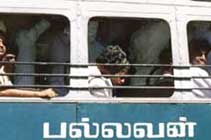
Virtual trip on Delhi's DTC buses
Some years ago, Delhi Transport Corporation (dtc) launched the Namaskar Seva. Under this the driver and conductor were to greet passengers with a namaste. The signboard in front of the bus did not

Some years ago, Delhi Transport Corporation (dtc) launched the Namaskar Seva. Under this the driver and conductor were to greet passengers with a namaste. The signboard in front of the bus did not
The objective of the Partnership for Sustainable Urban Transport in Asia (PSUTA) is to work with stakeholders in Asian cities to identify indicators of sustainable transport for use in policy making. It is a response to the extraordinary
the Rs 5,745-crore Mumbai Urban Transport Project's second phase (mutp-ii) for a suburban railway is facing a roadblock because the Union ministry of railways and the Maharashtra government disagree

Public Transport
The World Bank recently lifted its suspension of finances for the Mumbai Urban Transport Project, an ambitious road and rail renewal plan to improve public transport in the city. On March 1, 2006,
karnataka has become the first state in India to introduce ethanol-blended diesel to be used for transportation, amidst concerns about the feasibility of the technology. The 7.7 per cent blend of
In India, Gujarat was the first state to make commercial use of biodiesel in buses, but it reverted to regular diesel within months. The Gujarat State Road Transport Corporation contends it had to
lankan fuel crisis: Sri Lanka recently reached a settlement with the Lanka Indian Oil Corporation (LIOC), a wholly-owned subsidiary of Indian Oil Corporation, to resolve a fuel crisis in the
This article examines Bus Rapid Transit (BRT) as a near-term strategy for reducing CO2 emissions in a typical medium-sized U.S. city. The paper compares the expected CO2 emissions from three scenarios to meet the city's growth in work trips by 2011: a no-build option that relies upon private automobiles and a diesel bus fleet; building a light rail (LRT) system; and building a BRT system using 40-ft or 60-ft low emission
This report is in continuation to the EPCA report no. 21 of May 2006 The imperative of public transport: Implementing the High Capacity Bus System: a progress report which was in response to the Hon
A shift to public transport should avert the energy crisis
Stabilizing and reducing atmospheric greenhouse gas concentrations is essential to global sustainability and this will require intensified and ongoing efforts to increase overall global energy efficiency and a shift from fossil fuels to non-carbon energy sources. The improvements in global energy efficiency need to be achieved in a context of a growing population and economy.
This report contains the progress made on the implementation of the HCBS since Hon

The objective of this policy is to ensure safe, affordable, quick, comfortable, reliable and sustainable access for the growing number of city residents to jobs, education, recreation